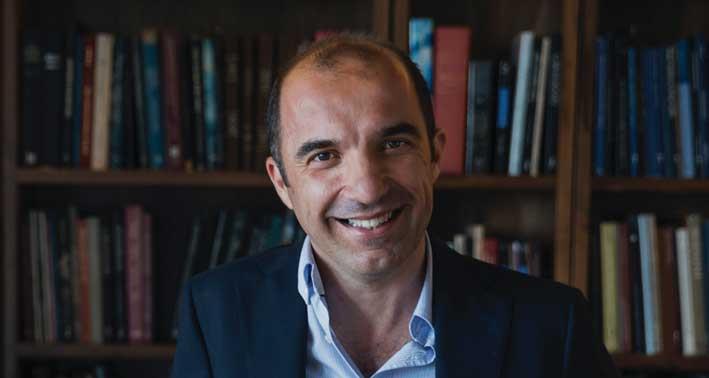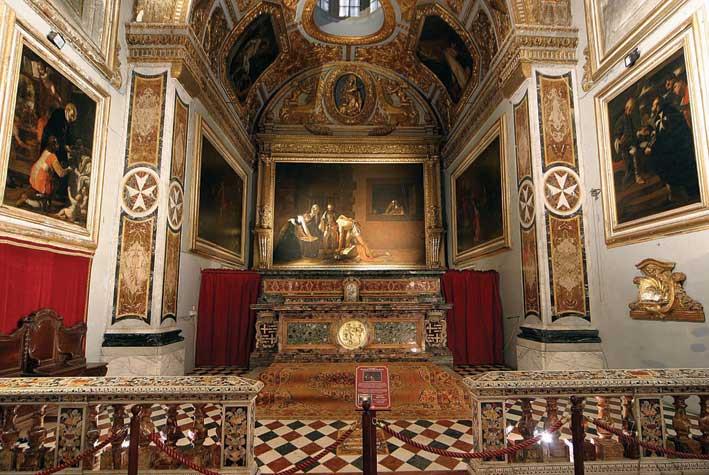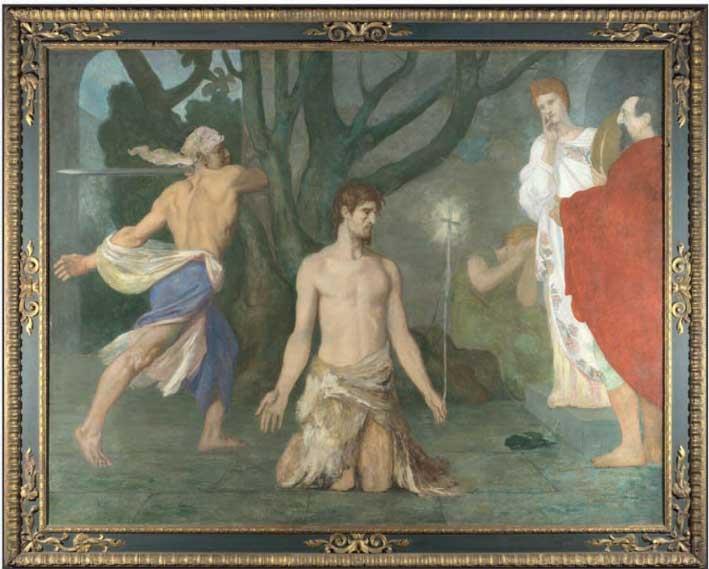For the upcoming Venice Biennale in 2022, the Malta Pavilion has chosen to engage with the Early Baroque masterpiece, The Beheading of St John by Caravaggio. According to Prof. Keith Sciberras, who is the team leader for this project, the team for the Malta Pavilion 2022 has chosen to create "a contemporary immersive engagement" with The Beheading of St John, which is located in the Oratory of the Decollato in St John's Co-Cathedral. The Early Baroque masterpiece will be grounded and juxtaposed within the modern and contemporary era of "metal and silence", as articulated by Prof. Giuseppe Schembri Bonaci. This painting depicts the cold-blooded martyrdom of St John the Baptist who foretold the coming of Christ and hence, the developments of the New Era. While there is great theological significance in St John's presence and role within the gospels, Prof. Schembri Bonaci states that the Maltese pavilion will not only engage with the theological themes of the painting as "it is not only a biblical Catholic narrative". The co-curators, Sciberras and New York-based Jeffrey Uslip, are not only transforming Caravaggio in relation to our contemporary times but also addressing salient values and ethical points. These are manifest in the combination of the various artistic levels: Arcangelo Sassolino's majestic kinetic structure, Schembri Bonaci's multitextual, multileveled Rosetta stone-like design and Brian Schembri's cosmic cross-temporal percussive score.

Prof. Giuseppe Schembri Bonaci
Diplomazija astuta is a wise and intriguing title that alludes to the diplomatically planned visit to Malta by Caravaggio to regain favour with the papacy. Moreover, it also refers predominantly to the partnership between Malta and Italy for the Venice Biennale of 2022. When interviewed by Emma Borg in The Malta Independent, published on 14 November, Sassolino was asked on the "theological element within the industrial mechanical aesthetic", he replied that despite the lack of a direct theological connection, he still is intrigued to capture "the fragility of life" and "the constant conflict[s]" that are present within it, echoing Sciberras' statement that the artists will be "[engaging] with the tragedies of humankind". He explained that by putting "material against material", he mirrors this battle which leads to his innovative artistic creations. However, there is a further link between the protagonist of Caravaggio's painting and the Maltese Islands, which goes beyond the parameters of theology and religion.
The Beheading of St John is a poetically beautiful subject, not only because of the influence which this work had on the acquired Baroque tastes within the Maltese Islands and the connections that Malta had under the Order of St John, but also because Malta is metaphorically taking the role embodied by St John within the contemporary artistic world. In the Book of Isaiah in the Old Testament there is a reference to "the voice of one calling in the wilderness", foreshadowing St John the Baptist, who helped forge the path for the coming of Christ and hence, the beginning of a New Age. Interestingly, there is a poetic and metaphorical parallel between Malta and the Baptist.

Prof. Keith Sciberras
Malta had been controlled by foreign powers for more than 500 years, during which it remained arguably on the periphery of history despite its formed connections and alliances. The country's history was relatively marginalised by the canonical developments that were rapidly emerging from cosmopolitan centres. The history of the canon and its exclusions came under radical scrutiny during the 20th century, leading to newfound interests in the artistic oeuvre and salient contributions of these non-cosmopolitan areas. Due to recent academic research and scholarship, Maltese art is beginning to emerge from the shadows of its insularity. Its recognition within the history of art is proof and product of the 20th century developments of shattered perspectives and the heteroglossia of truths. Malta's recognition and participation in the 2022 Venice Biennale is a testament to the artistic merit and value that the nation retains.

Arcangelo Sassolino'
The artistic project Diplomazija astuta will be representing Malta at the 2022 Venice Biennale international art exhibition. With this project for the Malta Pavilion, the Biennale team will not only be "[reflecting] on the spirit of Caravaggio's work", to use Sciberras' words, but will also be moving the country towards the forefront of the international artistic sphere, so as to compete with the major developments and forerunners of art. From the peripheral wilderness of the main cosmopolitan centres, the Maltese pavilion has poetically become the "voice in the wilderness", calling upon the artistic world to witness the birth of the New Age.
Diplomazija astuta will be curated by Keith Sciberras and Jeffrey Uslip, with the participating artists Arcangelo Sassolino, Giuseppe Schembri Bonaci and Maestro Brian Schembri. The Venice Biennale will be open to the public from 23 April to 27 November 2022.
The Malta pavilion is commissioned by Arts Council Malta, under the auspices of the Ministry of National Heritage, The Arts and Local Government.
Emma Borg
Located in the Oratory of the Decollato in St John’s Co Cathedral is one of Caravaggio’s most known works, The Beheading of St John. Without trying to be hyperbolic, this work is truly iconic and has come to inspire many generations of creatives, locally and internationally. Recently it was revealed that The Beheading of St John is an integral influence and focal point for the project, Diplomazija astuta at the Maltese pavilion at the upcoming Venice Biennale in 2022.
Although the Beheading is a biblical story, the team for the Maltese pavilion does not want the project to solely focus on the theological narrative. Instead, Diplomazija astuta seems to be more interested in engaging with the future while simultaneously subtly reframing the way contemporary viewers engage with Caravaggio’s Beheading. They are engaging with the future by referring to St John, who is a symbol of a new age in the Christian narrative. Furthermore, John is also a figure of change and continuation and Diplomazija astuta should be changing the manner in which the Beheading will be depicted yet simultaneously letting the story of the Beheading continue to live on. One must remember that with his version of the Beheading, Caravaggio was also able to bring forth a new sense of change and continuation. He engendered change by restructuring the traditional composition of the scene together with his masterly use of tenebrism. Thus, he was able to keep the narrative of the Beheading alive and relevant. Years after the artist’s death, Caravaggio’s Beheading continues to inspire artists such as Pierre Cecile Puvis de Chavannes with his version of the Beheading of 1869; the British film maker, Derek Jarmon in his film, Caravaggio in 1986 and, coming up in 2022, the contemporary curatorial project Diplomazija astuta.

Hannah Dowling
The Beheading of St John is a fundamental artwork both to Caravaggio’s oeuvre and also to the cultural history of Malta. With one of the main aims of the Malta Pavilion being to fuse Caravaggio with the contemporary, one may underline that this transformation of Caravaggio’s 17th-century masterpiece to the contemporary space of the Pavilion is ultimately highlighted by movement, theatricality and performance.
Movement, theatricality and performance are three terms which constitute the understanding of the contemporising of Caravaggio’s Beheading. Through Arcangelo Sassolino’s kinetic metal sculpture, together with Schembri Bonaci’s theoretic artistry and Brian Schembri’s musical composition, such principles are echoed. Overall, this immersive experience is brought to life with Keith Sciberras and Jeffrey Uslip’s curation, which enable the Malta Pavilion to unveil an atmospheric presence of dominating power and authenticity through daringness and artistic excellence. As a result, Diplomazija astuta envisions a collective presence which will be emitted precisely through this movement, theatricality, and performance. When considering all these points, the Pavilion project may be perceived as a Gesamtkunstwerk, a “total work of art”. While successfully fusing Caravaggio with the century of metal and with the contemporary is certainly no easy feat, one may argue that this will result in the Malta Pavilion emitting an overall immersive atmosphere which, once open to the public, must certainly be witnessed in order to be appreciated.

Pierre-Cécile Puvis de Chavannes, ‘The Beheading of Saint John the Baptist’, 1869, National Gallery. Image Source: National Gallery
Kylie Aquilina
The engagement with Caravaggio’s The Beheading of St John should be analysed in the context of the Oratory of the Decollato within St John’s Co-Cathedral in Valletta. This oratory uses the Baroque Macchina for the congregations and rituals of the Confraternita della Misericordia which culminates in the largest signed masterpiece by Fra Michelangelo, who arrived in Malta in July 1607 and whose name is poetically signed in the blood of St John, referring to the salvation of Christ.
The cycle of life and death is enhanced by the illusioned placement of the martyr over the altar, thus the processions in the oratory are a cycle that provide the martyr with a dignifying death reflecting the Order’s mission to aid convicted Christians while contemplating their imminent death. This act of pietà e misericordia is reflected in Caravaggio’s painting through the austerity of the painting and the composition of mourning figures and the two prisoners overlooking the beheading act.
As stated by Giuseppe Schembri Bonaci in his 2019 article in Melita Theologica: “The icon is the word made flesh: verbum dei caro factum est”. Therefore, Caravaggio’s painting is a visual narration of the act of the beheading conveying the devotion of the knights including Caravaggio himself in his preparation for the Knighthood of Magisterial Obedience. This Baroque Macchina, together with relics, encouraged the Knights to reflect upon the themes “justice, reconciliation and peace”. These themes are core to the Biennale project which were mentioned by one of the curators of the Malta Pavilion, Keith Sciberras, in the Venice Biennale Press Conference on 10 September. These themes were enriched by his numerous publications and onsite visits to St John’s Co-Cathedral where University students were immersed in the context of the Order’s rituals and artistic patronage. Thanks to the 2022 Malta Pavilion, visitors will engage with another layer to the Oratory of the Decollato, envisioned in the context of the 21st century through the work of the artists, Giuseppe Schembri Bonaci, Brian Schembri and Arcangelo Sassolino, and the curatorial vision of Sciberras and Jeffrey Uslip.
Main Bibliography:
David M. Stone, ‘Signature Killer: Caravaggio and the Poetics of Blood’, The Art Bulletin, xciv, 4 (2012), 571-593.
Giuseppe Schembri Bonaci, ‘Inverse, Reverse Perspective as Subversive Perspective in Florensky’s Silent Mutiny: A Debate’, Melita Theologica, lixi, 1 (2019), 47-67.
Keith Sciberras, ‘Caravaggio, the Confraternita Della Misericordia and the Original Context of the Oratory of the Decollato in Valletta’, Burlington Magazine, cxlvi, 1256 (2007), 759-766